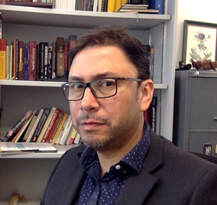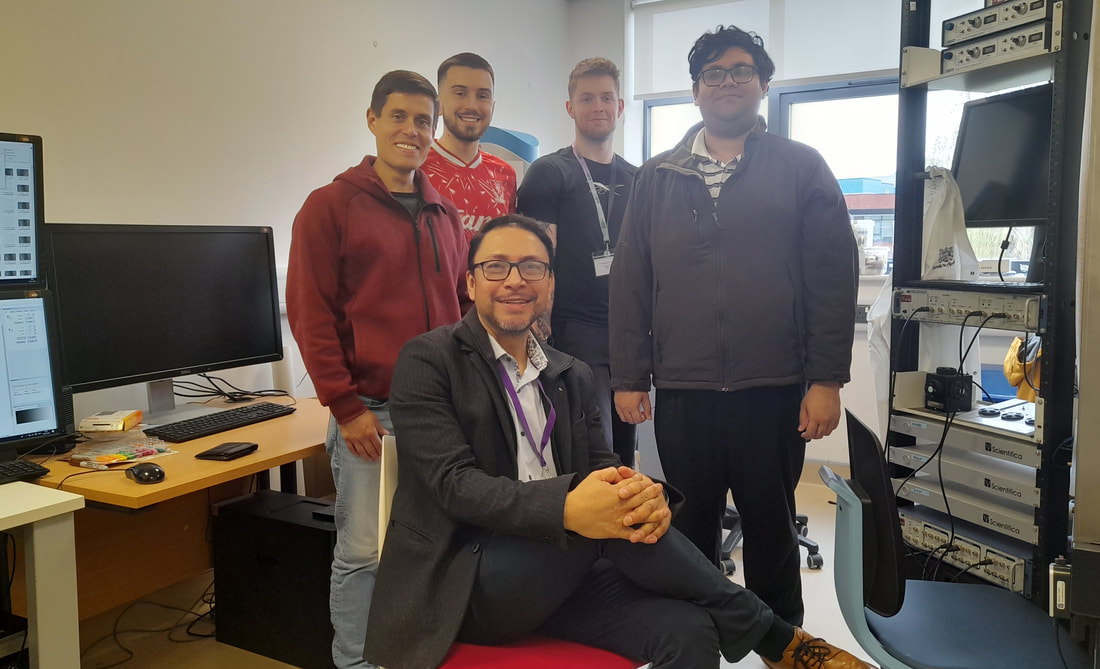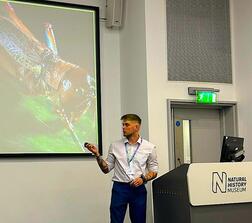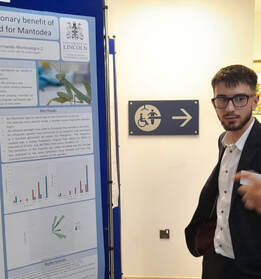The Bioacoustics and Sensory Biology lab
Academic history
2017-present Professor of Sensory Biology, School of Life Sciences, University of Lincoln, UK
2015-2017 Reader (Associate Professor), School of Life Sciences, University of Lincoln, UK
2012-2015 Senior Lecturer in Zoology, School of Life Sciences, University of Lincoln, UK
2008-2012 Human Frontier Science Program Research Fellow, Department of Biological Sciences, University of Bristol, UK
2005-2007 Postdoctoral Researcher, Department of Life Sciences, University of Toronto, Scarborough, Canada
Education
2016 P.G.C.E., School of Education, University of Lincoln, United Kingdom
2005 Ph.D., Department of Zoology, University of Toronto
1997 B.Sc., (Diploma, Biology-Entomology), Universidad del Valle, Colombia
Other appointments
2013-present Visiting academic, College of Life Sciences, Capital Normal University, China
2011-2012 Visiting Scientist, Muséum national d'Histoire naturelle Département Systématique et Evolution,
Paris, France.
2000-2007 Teaching assistant, Functional Morphology of Animals, University of Toronto, Canada
2000-2007 Teaching assistant, General and Forensic Entomology, University of Toronto, Canada
Google Scholar Profile
2015-2017 Reader (Associate Professor), School of Life Sciences, University of Lincoln, UK
2012-2015 Senior Lecturer in Zoology, School of Life Sciences, University of Lincoln, UK
2008-2012 Human Frontier Science Program Research Fellow, Department of Biological Sciences, University of Bristol, UK
2005-2007 Postdoctoral Researcher, Department of Life Sciences, University of Toronto, Scarborough, Canada
Education
2016 P.G.C.E., School of Education, University of Lincoln, United Kingdom
2005 Ph.D., Department of Zoology, University of Toronto
1997 B.Sc., (Diploma, Biology-Entomology), Universidad del Valle, Colombia
Other appointments
2013-present Visiting academic, College of Life Sciences, Capital Normal University, China
2011-2012 Visiting Scientist, Muséum national d'Histoire naturelle Département Systématique et Evolution,
Paris, France.
2000-2007 Teaching assistant, Functional Morphology of Animals, University of Toronto, Canada
2000-2007 Teaching assistant, General and Forensic Entomology, University of Toronto, Canada
Google Scholar Profile
Postdoctoral Researchers
Dr. Md Niamul Islam
Dr. Md Niamul Islam earned his undergraduate degree in BEng (Hons) Aerospace Engineering from the University of Manchester, UK, in 2017. Following this, he pursued an MSc degree in Advanced Aeronautical Engineering at Imperial College London, UK, graduating in 2018. Dr. Islam achieved his doctoral degree from Loughborough University, UK, in 2024, specializing in Mechanical and Manufacturing Engineering within the Wolfson School.
His research expertise lies in the manufacturing of 3D printed materials, especially composites, with a focus on quasi-static mechanical testing, dynamic impact tests, image processing, and numerical analysis of dynamic fracture. Currently serving as a postdoctoral research associate at the University of Lincoln, UK, Dr. Islam is engaged on scaled 3D printing of katydid ears to investigate the biophysical and ecological functions of these in 3D-printed models using various materials.
Dr. Md Niamul Islam earned his undergraduate degree in BEng (Hons) Aerospace Engineering from the University of Manchester, UK, in 2017. Following this, he pursued an MSc degree in Advanced Aeronautical Engineering at Imperial College London, UK, graduating in 2018. Dr. Islam achieved his doctoral degree from Loughborough University, UK, in 2024, specializing in Mechanical and Manufacturing Engineering within the Wolfson School.
His research expertise lies in the manufacturing of 3D printed materials, especially composites, with a focus on quasi-static mechanical testing, dynamic impact tests, image processing, and numerical analysis of dynamic fracture. Currently serving as a postdoctoral research associate at the University of Lincoln, UK, Dr. Islam is engaged on scaled 3D printing of katydid ears to investigate the biophysical and ecological functions of these in 3D-printed models using various materials.
Dr. Fabio Sarria-S.
Dr. Sarria-S is a field-experimental biologist with a strong background in sensory biology, insect biology, systematics and and taxonomy. He has a degree in Entomology from Universidad del Valle, Colombia, and received a PhD in 2018 from the University of Lincoln, UK. His experience in research includes biomechanics and engineering techniques like Laser Doppler Vibrometry, Micro-CT scanning, 3D reconstruction, ultrasound recording, motion detectors, and electrophysiology techniques. He is interested in contributing to the study of biodiversity using acoustic communication derived from animals under laboratory and fieldwork conditions. He has joined our new Leverhulme Trust project to work on hearing experiments on the katydid auditory system involving Laser Doppler Vibrometry and neurophysiology techniques.
Dr. Sarria-S is a field-experimental biologist with a strong background in sensory biology, insect biology, systematics and and taxonomy. He has a degree in Entomology from Universidad del Valle, Colombia, and received a PhD in 2018 from the University of Lincoln, UK. His experience in research includes biomechanics and engineering techniques like Laser Doppler Vibrometry, Micro-CT scanning, 3D reconstruction, ultrasound recording, motion detectors, and electrophysiology techniques. He is interested in contributing to the study of biodiversity using acoustic communication derived from animals under laboratory and fieldwork conditions. He has joined our new Leverhulme Trust project to work on hearing experiments on the katydid auditory system involving Laser Doppler Vibrometry and neurophysiology techniques.
Graduate students
Lewis Holmes
|
Dominic Rooke
|
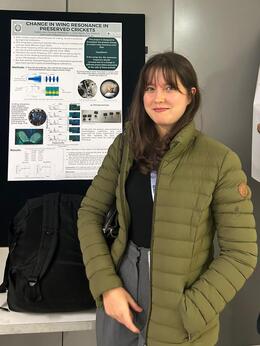
Visiting students
Sophia Lanski
Sophia is a French student under the Erasmus Mundus programme. She has joined the lab to receive training in bioacoustics. For her research project she is measuring the singing behaviour and wing resonances in alive males of several species of Eneopterinae crickets and in Gryllus bimaculatus. Her project aims to elucidate how the wing mechanical properties in crickets change after death, pinning, and preservation, as in museum collections. She is using standard acoustic equipment to record the calls of specimens from our colonies, and laser Doppler vibrometry to measure wing resonances in alive and death treatments. This is a follow up of a project developed by one of our former MSc students, which was severely affected by COVID-19.
Sophia Lanski
Sophia is a French student under the Erasmus Mundus programme. She has joined the lab to receive training in bioacoustics. For her research project she is measuring the singing behaviour and wing resonances in alive males of several species of Eneopterinae crickets and in Gryllus bimaculatus. Her project aims to elucidate how the wing mechanical properties in crickets change after death, pinning, and preservation, as in museum collections. She is using standard acoustic equipment to record the calls of specimens from our colonies, and laser Doppler vibrometry to measure wing resonances in alive and death treatments. This is a follow up of a project developed by one of our former MSc students, which was severely affected by COVID-19.
Undergraduate student projects
Shona Brown
Shona's project involves the study of local bats activity measuring and recording echolocation calls. She is investigating which species exhibit crepuscular activity, and which ones are active all night long. This project involves the use of the Echo Metre ultrasound digital recorder, which connects wireless to a data base that identify bat species.
Barney Payne
Male crickets produce calling songs to attract females using wing stridulation. The carrier frequency (CF) of the call is a function of body size, which allometrically affect other structures that also scale with CF. Barney’s project will test the hypothesis that body mass provides a better estimate of CF, over measuring body size and related structures. It is expected to see that body mass will have a higher correlation with CF than other morphological parameters (e.g. the length of pronotum, length of high femur, or body length).
Ethan Harling
This study aims to compile data on how domesticated cats develop sensory adaptations to respond to varying stages of vision deterioration and considers their application towards human pharmaceutical, physical and technological therapies. The primary aim is to discern how sensory adaptations in visually deprived domesticated cats influences their environmental responses (long-term) when compared to their sighted peers (short-term), and how this difference amplifies between individuals born with visual deterioration (lifetime) and those that develop it later in life (developed).
Shona's project involves the study of local bats activity measuring and recording echolocation calls. She is investigating which species exhibit crepuscular activity, and which ones are active all night long. This project involves the use of the Echo Metre ultrasound digital recorder, which connects wireless to a data base that identify bat species.
Barney Payne
Male crickets produce calling songs to attract females using wing stridulation. The carrier frequency (CF) of the call is a function of body size, which allometrically affect other structures that also scale with CF. Barney’s project will test the hypothesis that body mass provides a better estimate of CF, over measuring body size and related structures. It is expected to see that body mass will have a higher correlation with CF than other morphological parameters (e.g. the length of pronotum, length of high femur, or body length).
Ethan Harling
This study aims to compile data on how domesticated cats develop sensory adaptations to respond to varying stages of vision deterioration and considers their application towards human pharmaceutical, physical and technological therapies. The primary aim is to discern how sensory adaptations in visually deprived domesticated cats influences their environmental responses (long-term) when compared to their sighted peers (short-term), and how this difference amplifies between individuals born with visual deterioration (lifetime) and those that develop it later in life (developed).

